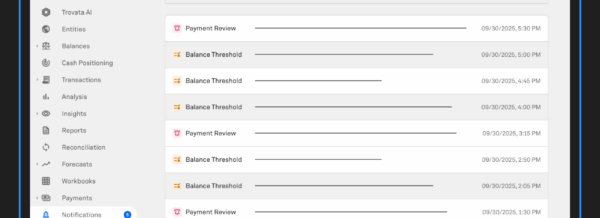You’ve probably already heard the saying that ‘data is the new oil.’ What started as a trickle in the late 20th century, has turned into a blowout geyser of data coming from every angle. But just like real oil, all that data is useless if it’s not harnessed correctly.
The level of data available in banking and financial services offers a range of opportunities that can transform the way a business operates and generates revenue. But to make the most of it, that data needs to be accessible, organized, and usable. And that represents a significant challenge to treasurers and finance teams trying to navigate ever increasing financial data management.
Organizations that do it right unlock some real, tangible competitive advantages. Those that ignore or underinvest in their data capabilities put themselves at serious risk of being left behind.
In this article, we’ll be looking a little closer at some of the opportunities available through the use of advanced data management and analytics, and over some of the key challenges in harnessing that data. And of course, we’ll discuss how to avoid them, to give your company the tools it needs to leverage its data for maximum benefit.

Opportunities in Financial Data Management Through Bank Data
As treasury and finance professionals already know, there is a vast amount of knowledge to be found within a company’s banking data. It can provide insights into the inner workings of an organization, show what is working, what isn’t, and what the future might hold.
Here are some of the specific benefits that can be access through enhanced data analytics and management, and some of the opportunities that come from this:
Enhanced Metadata
Before we get into the specific opportunities that enhanced data can offer, it’s worth understanding one of the reasons the opportunities are so great. Metadata. We’ve all heard the term used in a variety of different contexts, and in financial services it describes data points and information which go beyond the surface level.
For example, basic data is a transaction listing which shows how much money came in or went out. Many traditional connectivity methods show little more than this. Metadata provides a far richer view of the list, with details such as originating currency, payment method, counterparty information, and more.
The modern gold standard of data are APIs, which allow for vastly more data to be transmitted in a way that is standardized, real time and 100% accurate.

All of this can help guide insights on how and where cash flow is operating within a company, and uncover many growth opportunities or cost savings.
So with that said, how does better banking data result in better business?
More Targeted Sales and Marketing
One example is the way this data and the subsequent analysis can be used to assess current buying behavior. This could be in the form of trends within the data which show seasonal impacts that might not be obvious without the granular details.
For example, perhaps sales jump in Europe at a certain time of year. Detailed analytics will allow you to drill down and find out exactly where that sales bump is coming from, rather than using guesswork.
With that information at hand, company’s can tailor their sales and marketing efforts to take advantage.
More Efficient Use of Resources
Flowing from that is the ability to be more efficient with the use of resources. Sticking with the above example, say there is a specific sporting event in a region of Spain which is resulting in the increase in orders during that time every year.
Rather than allocating resources all across western Europe aiming to capture that uptick in demand, organizations can utilize a higher proportion of their budget in that specific region.
As well as that, enhanced data offers substantial opportunities for automation with everything from administration, account management, and forecasting. This saves time, and allows teams to operate leaner.
Better Forecasting
This one is pretty simple. With better data, comes better forecasting. The more information that you can gather, the more informed your future projections will be, and the better the strategic decision-making that is based on them.
Data as an Asset
Lastly, the data itself can be a significant asset to the business which adds to enterprise value. One high profile example in recent years has been Microsoft’s $26 billion acquisition of LinkedIn. As the world’s largest provider of enterprise software, the database of the world’s biggest professional network represented a huge asset.
The same is true of any company that gathers customer data.
Banking Data Challenges
That all sounds great, right? Get data. Win. In theory, yes, but as we know, real life is never quite that simple. There are some significant challenges to gathering, standardizing, and categorizing data in a way that makes it accessible and usable.
Much of this stems from the patchwork of different technologies and transfer methods that have been created over the years.
Connectivity and Normalization
There are a wide variety of file types and transfer methods when it comes to banking data. And of course, there’s no standardization in the way this data is presented. That makes it impossible to analyze data from multiple different sources, unless there is a normalization process in the middle.
Typically, this has been a process that has had to be done manually. However, Trovata has now become the global standard for bank connectivity, automatically normalizing data across every file type and transfer method.
This includes everything from legacy BAI files to API connections and everything in between, making your data immediately usable.
Scalability and Flexibility
One of the biggest problems with legacy systems such as TMSs and ERPs is the challenges in scaling. It’s not that they aren’t able to scale, it’s that scale comes at significant cost and takes a substantial amount of time.
In practical terms, it means disruptions every time a new account is added, and large transition issues for major events such as an acquisition, merger or joint venture.
API-first, cloud-native solutions like Trovata don’t have this same problem, acting as a repository for data using any connectivity method, and the ability to scale up and down in a very short space of time.
Analysis Capabilities
An onslaught of more and more data is pretty useless if you don’t have the time and resources to analyze it all. Traditional methods of data analysis involving manual spreadsheets and formulas are fine for smaller datasets, but the more information that is added in, the more challenging and impractical this becomes.
This is why modern treasury and finance platforms like Trovata are leveraging AI and machine learning to help make this quicker. This isn’t a magic AI hype pill that does the job for you, but it does make it easier and quicker to find specific pieces of financial information, identify trends, and spot anomalies.
This shifts analysts’ time from finding the relevant information, to actually analyzing it.
The Bridge From Challenge to Opportunity
So there’s some clear, transformative benefits to leaning into the opportunities that data presents to your business. And there’s some clear challenges in practically doing it. Enter Trovata, a solution designed to bridge that gap.
At its core, Trovata functions as a conduit for all of your disparate sources of financial data, and consolidates it in a way that makes this information accessible and usable.
Standardized Bank Data for Any Connection Method
Trovata is the first global standard for corporate bank APIs and legacy transfer protocols. This means unmatched levels of connectivity and access to your data (and metadata!).
Our extensive library of corporate bank APIs ensures seamless integration with a vast array of financial institutions. But we also understand the reality that not all banks offer APIs. In those cases, Trovata can also connect with banks through secure sFTP connections, meaning all of your data can be consolidated. And we mean all of it.

This combined API and sFTP approach adapts to the changing tech landscape, giving you a future proof solution you can rely on.
“I gravitated to Trovata because of the APIs. The daily feed makes data readily available. Transaction tagging allows for easy categorization and a clear picture of cash flow. Logging in provides instant updates, eliminating the need for manual data pulls.”
Bruce Edlund Assistant Treasurer at Cloud Software Group
Seamless Data Flow Across Your Tech Stack
Treasury and finance teams leverage a variety of software solutions for data analysis. These disparate systems typically lead to silos and fragmented data. Trovata empowers treasury and finance teams to break down silos with a truly unified financial picture.
Trovata doesn’t just centralize your bank data, it makes it readily available wherever you need it. Our APIs aren’t limited to bank connectivity, they also allow for integrations with your ERP and a number of other fintech systems.

Additionally, Trovata’s Workbooks feature enables you to export your data directly into spreadsheets, empowering cross-departmental collaboration and analysis. This flexibility ensures your critical financial insights are accessible to everyone who needs them, fostering better decision-making across your organization.
Need a custom integration? Our robust developer portal provides comprehensive APIs that allow for custom integrations so you can build workflows for your unique needs.
This suite of solutions enables a fluid financial ecosystem that fosters cross-functional collaboration. With everyone operating from the same data, the entire finance department gain a single source of truth for financial analysis.
Automated Workflows to Free More Time for Strategic Analysis
AI has become a buzzword. As far as treasury and finance goes, you shouldn’t expect to be able to put your feet up and stick your tech on auto-pilot, but automation does offer some massive benefits to your workflow.
AI-powered systems intelligently and automatically classify and tag vast amounts of data based on predefined rules or learned patterns. This automation reduces the manual effort required to organize that data, freeing up valuable time for your team to focus on strategic analysis.

It also helps with forecasting, giving users the ability to automatically populate models with real-time data, and helps you to quickly and easily change assumptions and view different scenarios.
Speed and Scalability to be Prepared for Organizational Expansion
Scalability is another key advantage of Trovata’s cloud-native solution. Whereas legacy cloud-based platforms are designed and built to run via on-premises physical servers, cloud-native platforms offer a scalable solution that isn’t limited by physical infrastructure.
This means you’ll be prepared to seamlessly integrate new banks and accounts as your organization grows and expands operations.
But scale isn’t just about adding more data. One of the biggest challenges in banking data is cloud-based (learn the difference between cloud-native and cloud-based) legacy systems can’t handle processing millions of transactions.
Trovata is built for the cloud, meaning our platform leverages scalable processing power. This ensures smooth performance, even with massive datasets. No matter how complex your financial landscape becomes, Trovata can handle it with ease.
Enhanced Data Management
In short, Trovata ensures that your data is complete, accurate, and available at all times regardless of scale. But that’s just the foundation for taking advantage of the data opportunity. To fully realize the benefits, you need to be able to use and manipulate that data.
Trovata simplifies data management with a range of features designed to give users actionable insights from that information. Transaction tagging and Trovata Query Language (TQL) search functionalities make it easy to find specific data points.

Additionally, Trovata leverages AI and machine learning for automated reporting and forecasting tools that give treasury and finance teams the insight they need to become true strategic partners of the business.

All of this can be built into customizable dashboards, with comprehensive permission and approval processes built in, keeping every role in the business updated and efficient in their day-to-day.
Trovata: The Data Solution for Modern Treasury
The challenges of managing vast amounts of banking data are significant, but with the right tools and technologies, they can be overcome. And it’s worth the effort, with data analysis offering huge opportunities to organizations who do it best.

Trovata offers a comprehensive solution that transforms these challenges into opportunities, providing the infrastructure and intelligence needed to leverage your data for maximum benefit.
If you want to see how Trovata could enhance your treasury and finance capabilities, book a demo today.




